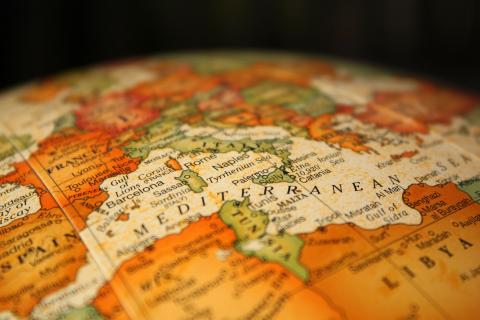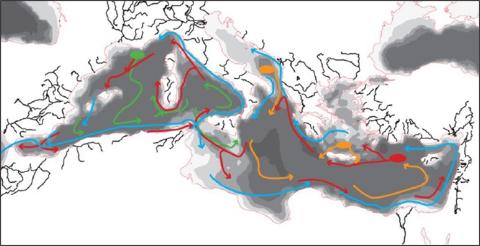
MedSens or the circulation of water masses in the Mediterranean: uncovering the past to predict the future
At a time when the Mediterranean Sea plays a pivotal role in shaping the climate of its surrounding nations, the MedSens project, a collaboration between the Geosciences Paris-Saclay Laboratory (GEOPS - Univ. Paris-Saclay, National Centre for Scientific Research CNRS), the Laboratory of Climate and Environmental Sciences (LSCE - Univ. Paris-Saclay, the French Alternative Energies and Atomic Energy Commission CEA, CNRS, Univ. Versailles Saint-Quentin-en-Yvelines UVSQ) and the European Centre for Research and Teaching in Environmental Geosciences (CEREGE - Aix-Marseille Univ., CNRS, French National Research Institute for Agriculture, Food and Environment INRAE, Research Institute for Development IRD), has embarked on a journey to delve into the Mediterranean's past to gain insight into its response to climate disruption. Led by Christophe Colin, a geochemist and paleoclimatologist at GEOPS, the team is attempting to reconstruct the millennia-old circulation patterns of this sea using a unique marker: neodymium, a chemical element found in the seabed sediments.
As well as being a focal point for significant economic, cultural and political exchanges, the Mediterranean Sea plays a crucial role in regulating the climate of the countries that surround it. Indeed, the thermohaline circulation ("thermo" for temperature and "haline" for salinity) of the Earth's seas and oceans contributes to heat distribution across the planet. Furthermore, cold and saline water masses sink and transport oxygen (O2) and carbon dioxide (CO2) to the ocean floor.
A dually sensitive circulation
The Mediterranean Sea is a semi-enclosed basin with two circulation areas: one basin in the west, connected to the Atlantic Ocean, and the other in the east, into which the Nile flows. As North Africa is a desert region, very little water comes from the south. "The Mediterranean's water balance is in deficit, meaning that evaporation from the sea exceeds the freshwater input from precipitation and rivers. At the Strait of Gibraltar, salinity is roughly normal, but as the surface water flows eastwards, it evaporates and we get very high salinities in the Eastern Mediterranean," explains Christophe Colin.
In addition to these varying salinity levels, winter surface cooling causes saline water masses to sink to the north, oxygenating the bottom of the Mediterranean. "It's incredibly sensitive: these downwellings depend on small changes in surface salinity and temperature. If surface conditions change, the water no longer sinks. This is crucial, because without this circulation, the bottom of the Mediterranean would become anoxic: there would be no oxygen, no life," explains Christophe Colin.
Adapted from Colin, C., Duhamel, M., Siani, G., Dubois-Dauphin, Q., Ducassou, E., Liu, Z., et al. Changes in the intermediate water masses of the Mediterranean Sea during the last climatic cycle - New constraints from neodymium isotopes in foraminifera. Paleoceanography and Paleoclimatology, 36, (2021).
Exploring traces of past circulations
Christophe Colin is leading part of the MedSens project, which started at the end of 2019 with funding from the French National Research Agency and is coming to an end. Its objective is to reconstruct ancient circulation patterns in the Mediterranean. Alongside his team, the researcher is looking at events that introduced fresh or low-salinity water into the Mediterranean basin, thereby disrupting the thermohaline circulation and depriving the seabed of oxygen. "The inflow of freshwater from rivers also brings nutrients including nitrogen, phosphorus and iron," explains the researcher. “These elements boost surface productivity. They are consumed by phytoplankton organisms that accumulate on the ocean surface. When these microalgae die, the organic matter descends into the water column and degrades through bacteria, which consume the oxygen in the water."
Such processes, along with the stratification of the Mediterranean - a phenomenon where water separates into multiple layers, observed in all the world's oceans and seas - result in a loss of oxygen and benthic life (species living at the bottom of the sea or freshwater). "You then accumulate organic matter in sediments: sapropeles," explains the researcher. Using these black sediments, scientists can identify periods of reduced thermohaline circulation in the Mediterranean. This reduction is caused by water inflows: either from the cold and low-salinity Atlantic currents during interglacial periods, or from the Nile and North African paleo-rivers, activated during monsoons. "There are times when rainfall in Africa has increased. Earth's insolation in the northern hemisphere increases every 23,000 years, at which point the intertropical front from central Africa moves far north. This is the Green Sahara." In order to model the circulation of the Mediterranean accurately and understand the exact origin of the sapropeles, Christophe Colin is attempting to determine the source of the water.
Neodymium to trace the source
The surface of the seas and oceans is an active interface with the atmosphere. The composition of the atmosphere and the circulation of water masses at a given time leave behind an identifiable chemical signature in the sediments. This signature is determined by the isotopic composition (the proportions of the different isotopes or variants) of neodymium, a chemical element belonging to the lanthanide series and rare earths.
Even in the presence of low oxygen levels (anoxia), benthic life is scarce, but some foraminifera (single-celled organisms with shells) still thrive near the surface. When these organisms die, they sink to the seabed and become encrusted with neodymium-laden iron oxide. "By measuring the isotopic composition of neodymium, we can determine the origin of the water at the bottom of the oceans: whether it comes from the west and therefore from the Atlantic, or from the east, with completely different signatures, originating from the Nile," says the researcher.
The neodymium analysis is based on a calculation that considers two isotopes of this chemical element. Scientists extract a deviation from the Earth's average isotopic composition, known as εNd. "When εNd increases, the values are said to be more radiogenic and higher. In the Mediterranean, these higher values often indicate water masses originating from the east," explains Christophe Colin.
In a recent study, the GEOPS team presented a circulation model based on comparisons of sediment core records from both the eastern and western Mediterranean, spanning 140,000 years. "We demonstrated that during glacial periods, when sea levels were 120 meters lower, the neodymium isotopic composition was disconnected between east and west. However, as sea levels rose to their present-day levels, the basins reconnected and Atlantic water entered the eastern basin. Since this water was already somewhat desalinated, this led to a decrease in the salinity of the eastern basin, which serves as a precursor to the halt of the thermohaline circulation. If the Nile or other paleo-rivers arrived at that time, it represented the final push towards the formation of sapropels."
Adapted from Colin, C., Duhamel, M., Siani, G., Dubois-Dauphin, Q., Ducassou, E., Liu, Z., et al. Changes in the intermediate water masses of the Mediterranean Sea during the last climatic cycle - New constraints from neodymium isotopes in foraminifera. Paleoceanography and Paleoclimatology, 36, (2021).
An uncertain future
If conditions similar to those of the past occur in the future, the Mediterranean is highly likely to react in the same way, hence the need to understand its climatic history. "This involves identifying its thresholds for accepting freshwater or experiencing aridification leading to increased evaporation. Our study is a test bed for developing models and attempting to formulate circulation scenarios related to extreme cases encountered in the past," confides Christophe Colin.
However, such an approach does have its limitations. "The mechanisms studied unfold over thousands of years. Meanwhile, human beings are currently disrupting planet Earth on a 50-year timescale, which is unprecedented. Nature has never been capable of such rapid changes. In addition, humans have significantly altered rivers; the course of the Nile, is no longer entirely natural." By aiming to achieve a better understanding of past events through emerging isotopic tracers, the MedSens project is helping to anticipate the consequences of a climate experiencing unprecedented disruption.
Reference:
Colin, C., Duhamel, M., Siani, G., Dubois-Dauphin, Q., Ducassou, E., Liu, Z., et al. Changes in the intermediate water masses of the Mediterranean Sea during the last climatic cycle - New constraints from neodymium isotopes in foraminifera. Paleoceanography and Paleoclimatology, 36, (2021).


